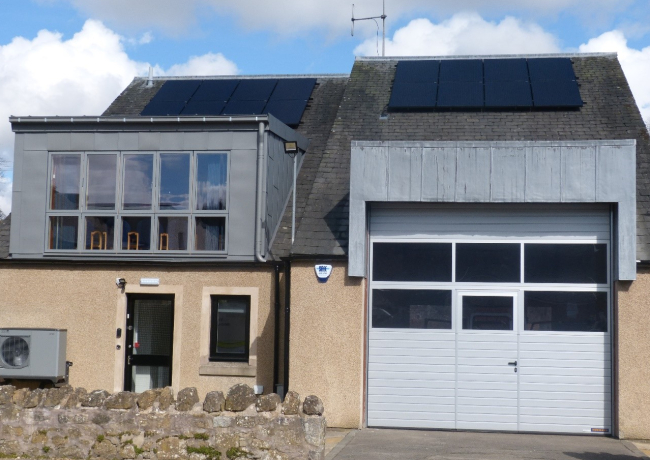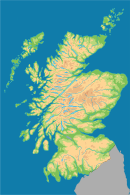St John’s Base Energy Efficiency Solution

Contact details: Pete Matthews, Team Leader
pete.k.matthews@hotmail.co.uk
07585900430

Location
“LEADER funding has given us the opportunity to install renewable technology into our new team base that we would otherwise not have had access to. This will not only reduce our impact on the environment but also reduce running costs to the team allowing us to divert more of the teams precious funding to directly support our search and rescue activities. This is good news both for the team and the community we serve.” Pete Matthews, Team Leader Tweed Valley MRT
What are the aims of your project?
Tweed Valley Mountain Rescue Team is a charity based in the Scottish Borders and are part of a network of Teams affiliated to Scottish Mountain Rescue. Team members are all volunteers and we provided a search and rescue capability which is deployable by Police Scotland. In April 2016 through the generosity of St John Scotland we took possession of the former fire station in Melrose which will become our new team base. The LEADER funding sits within a wider project to renovate and refurbish the fire station and make to fit for use as an operational Mountain Rescue base. A key priority for this project is that building should be low maintenance and energy efficient in order to reduce ongoing running costs to the team and to reduce the building’s carbon footprint and its impact on the environment. LEADER funding allows us to install renewable energy technologies and improve the energy efficiency of the building that will achieve these aims.
How did your project achieve these aims?
The LEADER funding will assist with a number of initiatives which achieve our aims of energy efficiency. This includes: a bank of solar photovoltaic (PV) cells installed on the south aspect of the building roof which allows us to generate our own electricity; a battery storage system for the electricity generated by the PV cells so it can be used on demand; an air source heat pump (ASHP) to efficiently convert electricity into heat; a hot water cylinder and wet heat delivery system to distribute heat from the ASHP to the building; modern efficient space heaters for the garaging area and low voltage LED lighting throughout the building. Although outwith the scope of the LEADER project the wider renovation of the base will also see improvements to the building which will increase the energy efficiency. This includes replacement of aging windows and increasing the amount of insulation in the loftspace.
Who’s involved?
The project is being overseen by a committee of team members and trustees. We are also indebted to the support given by our technical team including Oberlanders Achitects LLP, CBA Quantity Surveyors, Hulley and Kirkwood consulting engineers and MacKay and Partners structural engineers. We are pleased to have appointed local firm Beech Joinery and Building limited as our principle contractor for the renovation project with much of the LEADER funded work including the renewables subcontracted out to another local firm Renew Green Energy.
How was the project funded?
The wider base project has received major support from St John Scotland who have both purchased the site and provided a grant toward the renovation of the building. In addition the team is investing a significant proportion of its reserves into the project which have been built up over recent years for this purpose through donations and fundraising. In addition smaller grants have been received from the Hayward-Sanderson Trust and the NFUS Centenary Trust.
The LEADER funding is a significant part of the overall project and without which it would not have been possible to achieve our aims of maximising energy efficiency and minimising our carbon footprint through use of green technologies. Match funding for LEADER comes from the team’s reserves.
Where did you go for help and advice?
We are extremely fortunate to have the assistance of our technical team who have freely provided their professional services to support the project. We have also had advice from our principle and subcontractor who have inputted on the technical side of the project. In addition we have within the team volunteer members with specific knowledge in areas which have been beneficial to the project. These include knowledge of the building trade and property services, experience of project management and local knowledge and liaison.
The Scottish Borders LEADER team have also been extremely helpful with advice and assistance with completing the application to the LEADER fund and with the claim process.
What has been your greatest achievement so far?
The project to replace our base first started almost 10 years ago and it has taken considerable time to identify and secure a suitable site. The former fire station in Melrose was identified early on as an ideal building and location for our new base but initially we discounted it as beyond our means. We considered a number of other sites over the years bit no others ticked all the boxes we were looking for. It was only with the offer of assistance from St John Scotland that were we able to secure the site in Melrose and it was hugely satisfying and something of a relief when we finally took possession of the building in April 2016. However the last 15 months have been busy ones with drawing up plans, getting planning consent, securing funding, building warrants and preparing tenders. We are delighted now to have progressed the project to the stage where renovation work and installation of our green technologies is underway.
And the biggest challenge?
We are an organisation of around 40 members all of whom are volunteers. Being a member of a mountain rescue team means much more than just attending callouts. We expect our members to keep a high attendance at training, support the team by attending various events where we provide first aid cover, fundraise on behalf of the team and also to help organise and administer the team. All of this represents quite a demand on our volunteers time all of whom also hold down day jobs and have families and loved ones at home. The new base is by far the biggest project the team has ever undertaken and managing this on top of all the other demands of the team has been a challenge. The new base project is also a significant financial consideration for the team. Ensuring we have sufficient funding in place to fulfil our ambitions for the base but without placing the team in financial jeopardy in doing so has also been a challenge and one where the LEADER funding has been particularly crucial.
Any tips for those setting up a similar project?
The key to the success of our project has been putting the right team in place to manage the project. This means drawing on the different skills of our members and also bringing in people from out with the team who have particular skills required for the project. We have also been ambitious for our project and investing the time and effort to secure funding and other support has also been important. At times this has been challenging but being prepared to seek help and advice from partner organisations has been hugely beneficial to us. This is particularly true of LEADER where the application process and administration of the grant could seem daunting to small organisations but where the LEADER team have been very supportive and encouraging.
What’s next for your project?
The build phase of the project is now underway with alterations to the layout of the building and a dormer extension to the upstairs classroom being added. The renewable technology and heating system will be installed over the coming weeks and should be fully installed by the end of September. The build phase is due to be complete by the 9th October after which we will spend some time on internal fixtures and furnishing and finishing touches such as external signage and work to upgrade the drill yard to the rear of the building. Also allowing time to move across from our current base in Selkirk we hope and expect to be using the building operationally before the end of 2017.
With funding from the Scottish Borders LEADER programme, the Tweed Valley Mountain Rescue Team were able to extend their building to include a new purpose built training room, and also installed solar panels to reduce the carbon footprint of their base.
- Log in to post comments